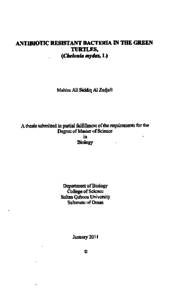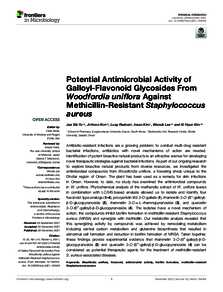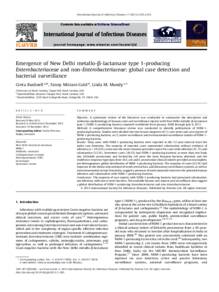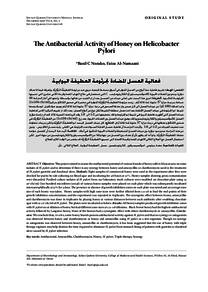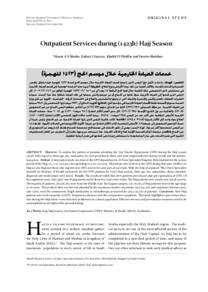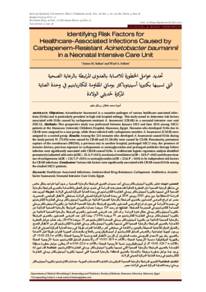Document
Antibiotic resistant bacteria in the green turtles (Chelonia mydas, L)
Publisher
Sultan Qaboos University
Gregorian
2011
Language
English
Subject
English abstract
Oviductal fluid from 40 green turtles (Chelonia mydas) turtles from Ras Al-Hadd Reserve were examined for the presence of antibiotic resistant bacteria. The samples were collected from the cloacal vent during oviposition using a non-invasive procedure. Each sample was obtained by inserting a 15 cm sterile swab gently into the cloacal vent, as the sphincter muscle is relaxed and the cloacal lining is unfolded to the outside. A total of 42 bacteria from 11 genera were isolated. A phylogenetic tree was constructed for the 42 bacterial isolates and heterogeneity in the phylogeny of bacteria was evident. The dominant isolate was Citrobacter. Among the isolates 85.3% showed multiple resistance to 15 tested antibiotics. Resistance to ampicillin and streptomycine was the highest, followed by sulphamethoxazole. Twenty two ampicillin resistant isolates were screened for three classes of B-lactamases. Screening showed that 31.8% were extended-spectrum B-lactamases (ESBL) screen positive, 18.2% were AmpC screen positive, while 31.8% were screen positive to both ESBL and AmpC type B-lactamases. All the isolates were screen negative to metallo B-lactamase production. Also, ESBL confirmatory test and multiplex PCR revealed negative results. However, according to IBT 27.3% were categorized as AmpC B-lactamase producers. In addition, multiplex PCR was used to identify the genes of screen positive isolates for ampc type B-lactamases. Out of the eleven AmpC screen positive isolates, only four showed positive bands. Sequencing revealed CMY and AmpR type B-lactamses. Sampling oviductal fluid for antibiotic resistant bacteria is valuable in assessing polluted effluents in feeding and migratory habitats of turtles. Tracking polluted effluents using bacteria as bio-indicator may influence reproductive potential in this endangered species.
Member of
Resource URL
Arabic abstract
لقد تم استخلاص و استخدام البكتيريا المقاومة للمضادات الحيوية كمؤشرات للتلوث البحري و ذلك عن طريق اخذ عينات اثناء وضع السلاحف الخضراء لبيضها في منطقة راس الحد، سلطنة عمان، التي تعد من احد اهم سواحل التعشيش في العالم. تم الحصول على كل عينة عن طريق ادراج مسحة 15 سم بلطف داخل المدرقية . جمعت العينات من اربعين سلحفاة. تم عزل 42 بكتيريا من الجنسا، مما يدل على تنوع البكتيريا وهذا ظاهر في الشجرة الوراثية، وكانت المهيمنة من نوع Citrobacter. من بين البكتيريا المعزولة 3. 85 % اظهرت مقاومة متعددة ل5 امضادا حيوي. مقاومة البكتيريا كانت الأعلى للمضاد الحيوي من نوع ampicillin و streptomycin. اثنان وعشرون بكتيريا مقاومة لل ampicillin تم فرزهم بحسب نوع الانزيم lactamase-م المنتج. اظهرت الفحوصات الأولية أن 8 . 31 % تنتج انزيم من نوع ESBL و 182 % تنتج انزيم من نوعAmpC و 8 . 31 % تنتنج النوعين معا. في حين لم يتم الكشف عن أي بكتيريا منتجة للانزيم من نوع metallo - B - lactamas . بالاضافة الى ان الفحوصات التأكيدية ل ESBL و ال multiplex PCR اعطت نتائج سلبية. في حين أن فحص IBT اكد ان 3 عينات (27. 3 %) هي منتجة ل AmpC . بالأضافة الى ان multiplex PCR اظهر وجود 4 جينات ل AmpC من 4 عينات مختلفة عن ما تم تحديده بفحص IBT . هذه الجينات كانت من نوع CMY و AmpR . من هذه النتائج نرى اهمية دراسة وجود البكتيريا المقاومة للمضادات الحيوية في سائل الاباضة بالسلاحف الخضراء. نظرا لكون السلاحف الخضراء مهددة بالانقراض. ووجود هذه البكتيريا الضارة يشكل تهديدا لها ولغيرها من الأحياء فضلا عن ما نستنجه من تلوث البيئة البحرية بمثل هذه البكتريا التي تتعجب لوجدها في الأحياء البرية كالسلاحف.
Category
Theses and Dissertations

